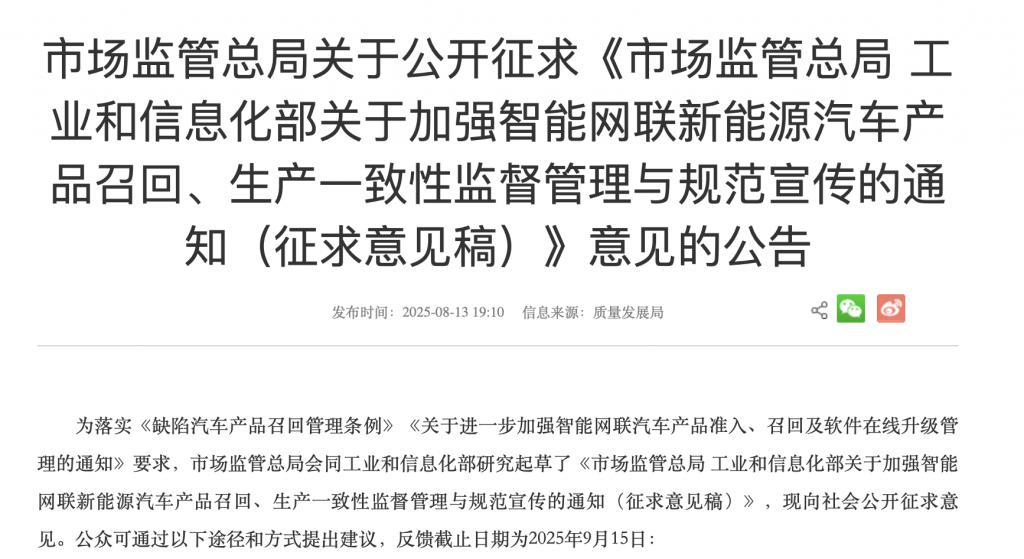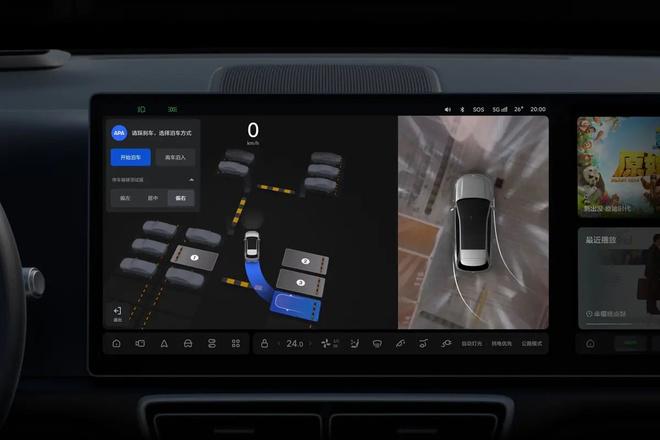New Smart Car Regulations: Hands Must Stay on the Wheel, OTA Updates Require Registration
The regulation of intelligent connected vehicles has been further strengthened to eliminate false and exaggerated advertising in intelligent driving. The filing of OTA upgrade activities has been reinforced, and the reporting and in-depth investigation of incidents and accidents involving intelligent connected new energy vehicles have been strengthened.
On August 13, the State Administration for Market Regulation, in conjunction with the Ministry of Industry and Information Technology, drafted the "Notice by the State Administration for Market Regulation and the Ministry of Industry and Information Technology on Strengthening the Supervision and Management of Recalls, Production Consistency, and Standardized Promotion of Intelligent Connected New Energy Vehicle Products (Draft for Public Consultation)" (hereinafter referred to as the Draft for Public Consultation), and solicited opinions from the public.
The State Administration for Market Regulation and the Ministry of Industry and Information Technology stated in the draft for public comment that, in order to effectively implement the "Regulations on the Administration of the Recall of Defective Automobile Products" and the "Notice on Further Strengthening the Access, Recall, and Software Online Upgrade Management of Intelligent Connected Vehicle Products," and in accordance with the "Advertising Law of the People's Republic of China" and the "Anti-Unfair Competition Law of the People's Republic of China" to regulate enterprise advertising activities and commercial publicity behaviors, further efforts will be made to improve the recall, production consistency supervision, and standardized publicity related to intelligent connected new energy vehicle products, so as to protect the legitimate rights and interests of consumers.
The draft for public consultation further strengthens the supervision of intelligent connected vehicles. Regarding intelligent driving, the draft proposes that enterprises should display safety warnings and usage instructions for combined driver assistance systems prominently on the vehicle's APP, in-vehicle information interaction systems, and user manuals, so that consumers can read, understand, and operate them easily, preventing drivers from mistaking the combined driver assistance functions for autonomous driving features.

Enterprises shall develop and use driver monitoring, warning, and handling functions with safety as the priority, closely monitoring the driver's driving status. When the driver exhibits behaviors such as hands-off driving or sleep, indicating disengagement from dynamic driving tasks, timely warning or control measures shall be taken, including voice alerts, steering wheel vibrations, speed limit enforcement, pulling over, and disabling combined driver assistance functions, to enable the driver to promptly take over the vehicle and reduce safety risks. At the same time, enterprises are required not to allow the driver monitoring, warning, and handling functions to be actively disabled through user operations or system logic.
Regarding OTA upgrades for intelligent connected vehicles, the draft for comments stipulates that automakers must strictly follow the classified management requirements for OTA (Over-the-Air) upgrade activities. No OTA upgrade activities may be carried out without prior filing. Unverified software versions that have not undergone sufficient testing must not be pushed to users. Automakers must not conceal defects through OTA upgrades, and must ensure that the intelligent connected new energy vehicles equipped with combined driving assistance systems are consistent with the approved products, bearing full responsibility for product safety. For companies that frequently conduct OTA upgrade activities, the State Administration for Market Regulation will carry out key spot checks and special inspections.
The draft for comments also proposes that companies must not engage in false, exaggerated, or misleading promotions regarding system capabilities in their advertisements and commercial activities, ensuring that consumers correctly understand and drive intelligent connected new energy vehicles. Beyond just the driving assistance systems, the draft also suggests that companies should avoid exaggerating the driving performance of vehicles, which might mislead consumers into driving vehicles at unreasonably high speeds.

The State Administration for Market Regulation will intensify supervision and inspection of enterprises’ advertising activities and commercial publicity behaviors that exaggerate the functions of combined driving assistance or deceive and mislead consumers. It will organize recall technical institutions to conduct technical identification of issues such as excessive publicity, and, together with the Ministry of Industry and Information Technology, carry out special joint investigations to regulate and rectify such practices in accordance with the law.
In addition, the draft for comments will further strengthen the reporting and in-depth investigation of incidents and accidents involving intelligent connected new energy vehicles. The State Administration for Market Regulation, together with the Ministry of Industry and Information Technology and other relevant departments, will enhance in-depth investigation and analysis of accidents, and supervise and inspect enterprises’ accident reporting. If it is found that enterprises fail to report accident information as required, such cases will be publicly disclosed and rectification will be urged. If enterprises conceal or omit major facts in incident or accident reports, the State Administration for Market Regulation and the Ministry of Industry and Information Technology will conduct special investigations.
This year marks the inaugural year of the widespread adoption of driver assistance systems. Hype-driven marketing, alongside the popularization of technology, has not only intensified the industry’s cutthroat competition but also affected consumers’ car purchasing decisions and driving experiences.
In order to promote the steady development of intelligent connected new energy vehicles, the Ministry of Industry and Information Technology and other departments have strengthened the supervision of new technologies such as driver assistance systems since April. This has led car manufacturers to focus more on accuracy and less on hype when promoting driver assistance systems.
Continuously strengthening regulatory efforts will further protect consumer rights and driving safety, promote the orderly and stable development of intelligent connected new energy vehicles, and prevent vicious "involution-style" competition.
【Copyright and Disclaimer】The above information is collected and organized by PlastMatch. The copyright belongs to the original author. This article is reprinted for the purpose of providing more information, and it does not imply that PlastMatch endorses the views expressed in the article or guarantees its accuracy. If there are any errors in the source attribution or if your legitimate rights have been infringed, please contact us, and we will promptly correct or remove the content. If other media, websites, or individuals use the aforementioned content, they must clearly indicate the original source and origin of the work and assume legal responsibility on their own.
Most Popular
-

EVA Morning Prices on September 12: Most of the Market Holds Steady, Highest Rise of 50 Yuan
-

[PET Weekly Outlook] Polyester Bottle Chips Expected to Oscillate and Warm Up with Costs Today
-

List Released! Mexico Announces 50% Tariff On 1,371 China Product Categories
-

Top Ten Personnel Changes in the Auto Industry: Insights into Industry Anxiety and Progress | Vision 2025
-

Case Study | Clariant AddWorks™ Additives Solve Plastic Yellowing Problem






